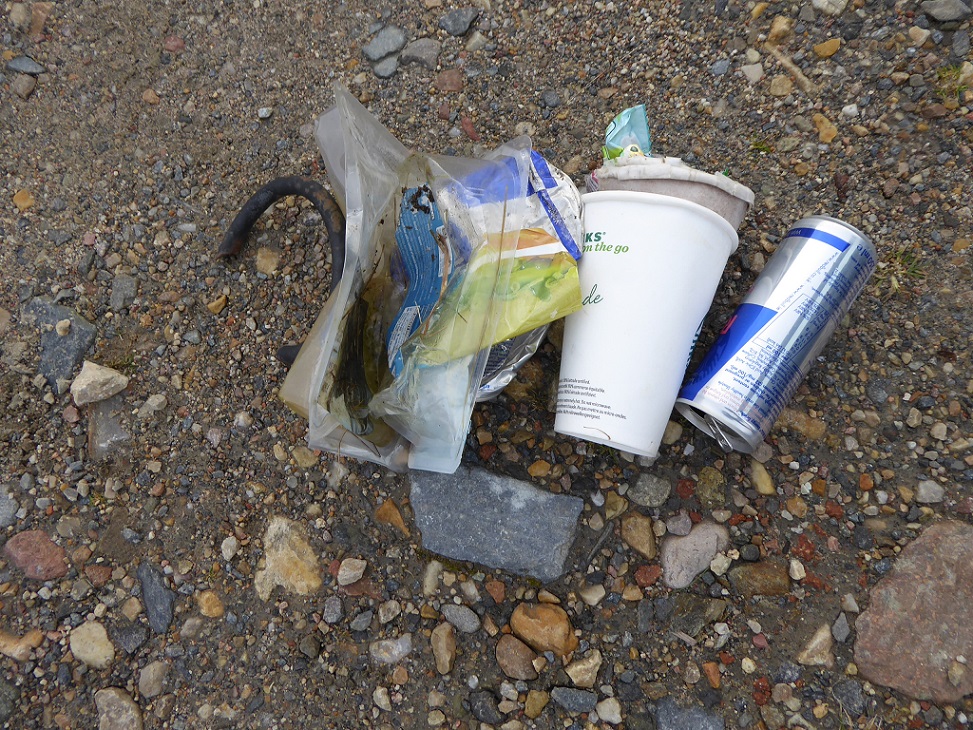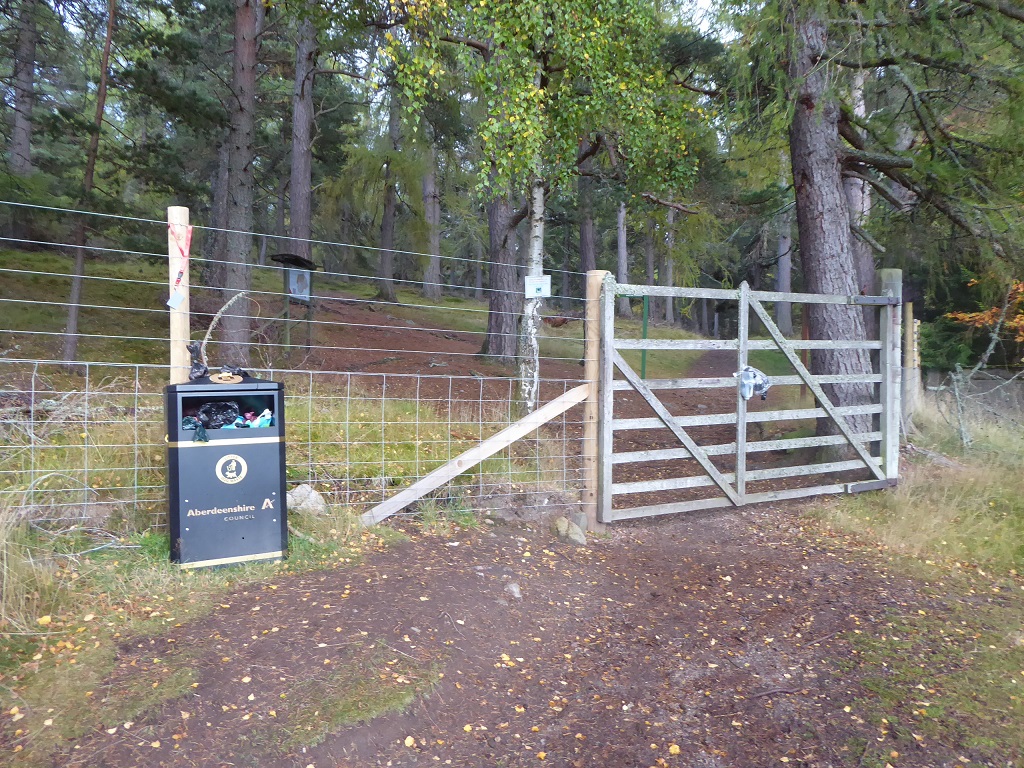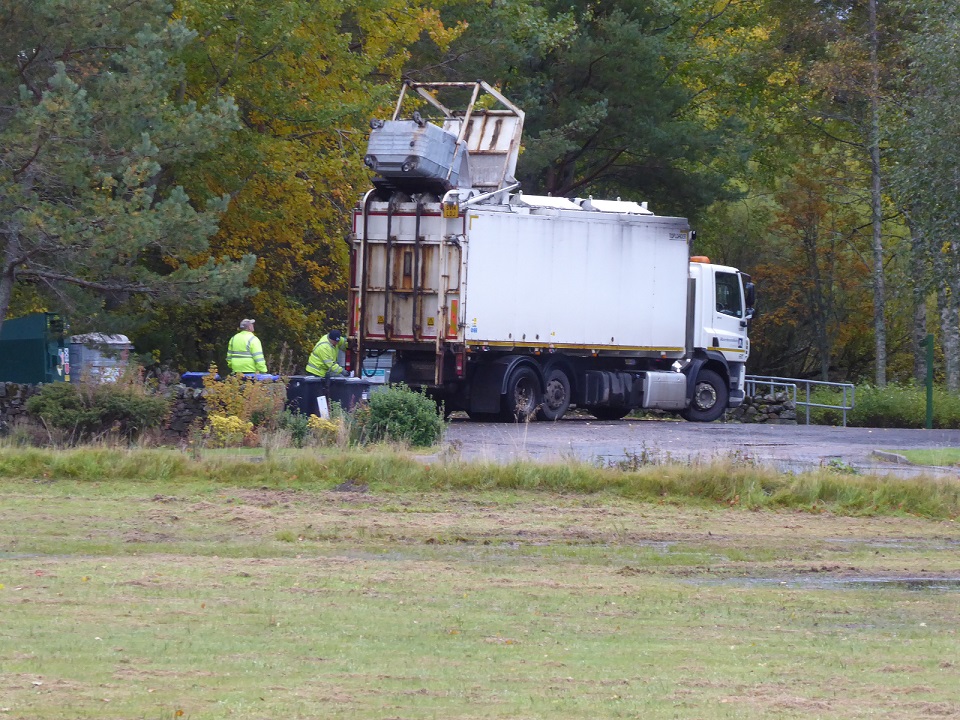I have been staying in Braemar for the week and so far have seen almost no litter (and no fly tipping) in the Cairngorms National Park, quite a contrast to the Loch Lomond and Trossachs National Park in the summer (see here). Even accepting that it is now quieter than August, the differences are quite stark as I will illustrate in this post.

On Sunday, I descended into Glen Shee from Creag Leacach to the car park which now forms part of the Scottish Scenic Routes Initiative (complete with camera stand and a long wooden seat – well designed for physical distancing). Now more used by tourists than hillwalkers, the car park, which is in the Perth and Kinross Council area, was spotless. Maybe the Council has been there earlier in the day with a squad of litter pickers but there was a large bin and I don’t think that was a coincidence.
Now consider that the Glen Shee ski centre is in Aberdeenshire so, assuming Perth and Kinross empty this bin, it is at the end of the road for them. If they can do it, so could Stirling Council provide litter bins at the Falls of Falloch where the Loch Lomond and Trossachs National Park Authority reported they had picked up vast quantities of rubbish earlier this summer.

I then walked the 2.5km back up to the ski centre, mostly on the verges of the A93 but following the old road where I could. It was a couple of hundred metres before I saw any rubbish but I then collected what I saw. It was not much. I reflected that if I had tried to walk 2.5km along the verges of the A82 by Loch Lomond I would have more likely have needed five bins bags.
After photographing my collection, I was pleased to dispose of it in the bins at the ski centre. While the enormous car park was mostly litter free, strangely in the place of one of the cars parked close to us was a bag of doggy poo. While I can understand why people wouldn’t want to carry this in their car – I had no intention of putting it in mine – we need to understand why people who do the right thing and bag their doggy poo then leave it for others to pick up.

I have not seen any litter in the four days since but I did fund this doggy poo bin which was overflowing. Most days I have been aware of the number of dog walkers, but I hadn’t realised it was this many. Again, people are doing the right thing, bagging their dog’s poo and carrying it for a while. But doggy poo is not the sort of thing most people want to be seen carrying though the village, let alone into the foyer of the Fife Arms Hotel. The bin is extremely well located and when I passed it again two days later it had been emptied.

On Wednesday, while taking a look at the Doune of Invernochty, two Aberdeenshire Council bin lorries stopped in the visitor car park, the first to empty the glass recycling bins (used by the whole community), the second to empty the general rubbish. It’s so basic, the same vehicle that empties bins from domestic properties also empties bins in laybys. So why can’t Argyll and Bute Council, the worst offender, and Stirling Council adopt this practice in the Loch Lomond and Trossachs National Park and provide litter bins in all laybys?
The problem is less money than attitudes to the visiting public. The Cairngorms National Park Authority has never had to deal with a serious litter problem because all its constituent councils know it is better to pre-empt litter through the provision of appropriate infrastructure. The LLTNPA by contrast faces an ongoing massive litter challenge because it is not prepared to take on Councils who fail to provide appropriate litter infrastructure. Instead, it keeps repeating the message “take your litter home”, a message that has been remarkably unsuccessful for twenty years now and then blames the public for doing the wrong thing. It should learn from how litter is managed in the Cairngorms.

Bin there, done that.
It is not really comparable, now to earlier in the year. Many if Perth & Kinross’s littwr bins in laybys werw overflowing with mountains of more rubbish piled around them.
This is no longer a time for testing the capacity of various councils’ steategies.
I have recently been watching a series of Youtube videos centred around a State Park in Utah and I noticed a few things to compare and contrast with the UK and particularly LLTPA experience.
The park is obviously heavily used especially in Summer, but I have seen no evidence of rubbish. I noticed that dumpsters were provided at the roadside next to one of the busiest areas.
Camping areas are provided, consisting of nothing more than a plastic stake marked “Camping area behind this stake. Maximum 14 days.” Again there was no sign of the litter or bags of rubbish which seem to be an inevitably accompaniment to such activities in Scotland. I would like to know how this is achieved, maybe it’s effective enforcement. maybe as your article suggests it really is as simple as provision of adequate facilities. Maybe the park admin just clears it up effectively.
If you read their research, the conclusions are pretty much spot on in line with Nick’s opinions in this blog – but some organisations here prefer to simply blame the visitors for not removing their litter when they go. To quote the findings of this research ““Many visitors are predisposed to be environmentally responsible and follow behaviors that benefit and protect national parks. Parks need to reinforce messages of moral responsibility and make it easy for them to dispose of waste properly.” See https://www.usu.edu/today/story/national-trash-reducing-waste-produced-in-us-national-parks — it’s not rocket science.
I see that research is heavily biased towards recycling which itself exacerbates the problem if it’s done wrongly. As with domestic collections some administrations have opted to try to make the individual produce sorted and processed waste placed in individual bins. This approach has obvious attractions for the authorities concerned but has a number of serious flaws;
It seriously complicates collections and increases the cost substantially if a complete range of bins has to be provided everywhere and each one has to be collected by a separate vehicle.
It leads to large quantities of recyclable material being landfilled due to “contamination” because the categorisations of the various types of waste are impractical and inconsistent – this is a problem I have noticed when camping, each area seems to have its own ideas of what goes in which bin and visitors may not notice and apply their “home” rules resulting in contamination.
A better solution is single bin collection followed by industrial processing. This also avoids the environmentally dreadful practice of requiring individuals to rinse rubbish with drinking water from the tap which loads the sewage system with raw food, when it should be done industrially using recirculated process water and the waste recovered and treated appropriately.
I suspect a better solution (in our National Parks) would be “any” bin collection… but, assuming that is managed, then you make some good points.
And interestingly I was up in the Trossochs this week – no bins, litter by the paths, and car park meters left vandalised and rusting. It really has the feel that no one cares. What particularly struck me was that the two most popular spots I passed – Ben A’An and Ben Venue – have the most unbelievably small car parks – both packed even at this time of year. If I contrast them with even the most unvisited spots in the Borders where I live. they are truly tiny! And the Borders doesn’t even have a National Park. Yet whether you want to hill cycle, walk or ride your horse, you can be guaranteed to find somewhere to stop near where you want to go – wherever you go. The Council and Forest and Land Scotland go out of there way to provide good facilities, as they see tourists as essential to the local economy – but also because they want to provide better leisure facilities for the local residents. As an example of this thinking, take a look at the fifty page “masterplan” they’ve produced (and are implementing) for just one, relatively small, forest (Glentress) and you can see what “good” looks like… https://scottishborders.moderngov.co.uk/documents/s8012/Item%20No.%206%20-%20Glentress%20Appendix%20A%20Masterplan%205%202%2016.pdf
I wonder if the contrast is because, in the Trossachs, there aren’t many “local residents” – and most of the land is owned by non-residents or faceless investment companies. Visitors don’t get a vote. Surely that’s why we need a National Park organisation to look after everyone’s best interests. Yet, dedicated to this purpose, they do much worse than the “generalist” local council and FLS who manage their scope in the Borders. Surely no better evidence is needed of a failing organisation, when the aims of a National Park are demonstrably better achieved – without them?
Yes, I have been hearing good things about Southern Scotland in this respect recently. My fear is that if this becomes too well known it will be seriously overloaded.
The problem with National Parks as implemented in Scotland is that individual recreation is way down their priority list and in fact seen as a problem not something to be encouraged – see LLTPA’s erosion of boating facilities on Loch Lomond and the camping byelaws for example.
Having so many visitors that the car parks become full would be a nice problem to have – in the example I gave about Glentress this happened, because it became such a well-marketed spot for hill cycling. So an arrangement was made to open a neighbouring field. Problem sorted. It’s not a shortage of land that stops these facilities being provided…